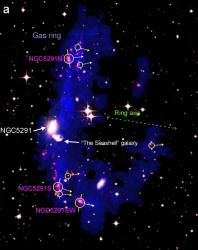Astronomers have found that the cosmic wreckage left over when large galaxies collide have an unusually high amount of unseen matter in them. In some situations, these dwarf galaxies have twice the matter that astronomers would expect.
The research was done using the National Science Foundation’s Very Large Array (VLA) radio telescope to study a galaxy called NGC 5291, located about 200 million light-years from Earth. About 360 million years ago, this galaxy collided with another, and the collision sent out streams of stars, gas and dust. These streams later coalesced into dwarf galaxies that orbit the parent galaxy.
Under the VLA survey, astronomers studied three of these dwarf galaxies, and found that they have two to three times the amount of dark matter as visible matter. Astronomers don’t actually think this is the mysterious non-interacting dark matter that makes up the bulk of matter in the Universe. Instead, it’s cold hydrogen molecules which are extremely difficult to see.
This cold molecular hydrogen likely came from the disks of the galaxies, and not the haloes.
Original Source: NRAO News Release

